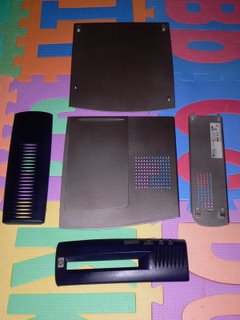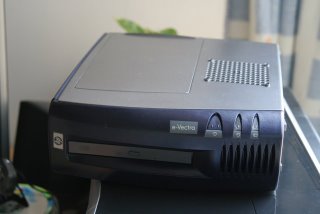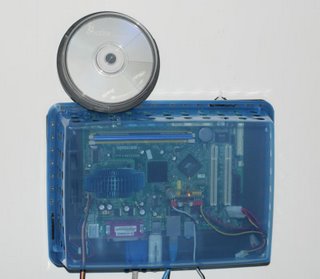
A budget system for under $260, monitor and operating system included!
In attempt to put together a small low cost data collection terminal, this little $260 system was born. This system makes use of the
PC Chips M789CG budget motherboard we looked at earlier, with an onboard VIA C3 800 mhz processor and also a 8.4" LCD monitor to keep cost down. Certainly the low processing power and small screen means it won't fit most user's needs, but besides being a data collection terminal, it could work well for light computer use (email, chat, skype, some browsing) as well as fit easily in tight spaces.
SETUP
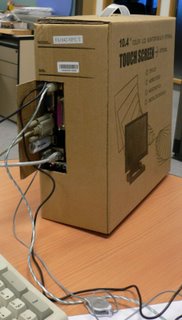 Installing it inside a cardboard box is actually not part of the cost saving solution (a proper PC case is included in the budget). It was meant to test if a small sized case would allow the system to run with sufficient cooling. Although it does make for an interesting case and even has a convenient carrying handle!
Installing it inside a cardboard box is actually not part of the cost saving solution (a proper PC case is included in the budget). It was meant to test if a small sized case would allow the system to run with sufficient cooling. Although it does make for an interesting case and even has a convenient carrying handle!
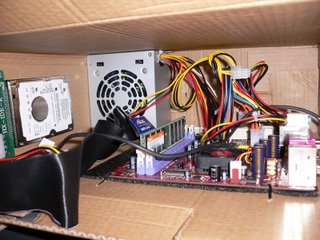 Here are the components setup inside the box. The motherboard is fixed to the box with twist ties, while the PSU and HDD are attached with screws.
Here are the components setup inside the box. The motherboard is fixed to the box with twist ties, while the PSU and HDD are attached with screws.
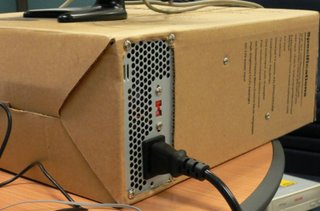 The power supply is a generic mATX sized. It's one fan is the only exhaust vent in this cardboard box case.
The power supply is a generic mATX sized. It's one fan is the only exhaust vent in this cardboard box case.
 A simply flap opening allows access to the motherboard I/O panel.
A simply flap opening allows access to the motherboard I/O panel.
LCD DISPLAY
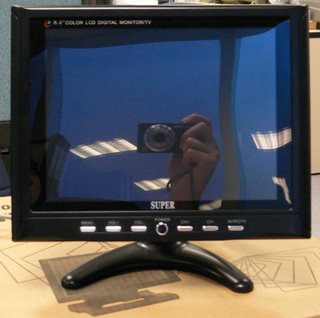 The screen is a tiny 8.4" LCD (the brandname is Super), the lowest cost display I could find with a native resolution of 800 x 600. Although not recommended for extensive use, for simple data entry or short periods of use it is acceptable. It also has a built in TV tuner as well as AV inputs, built in speaker, and remote control. The high gloss surface shows it is mainly for viewing video, but once it is turned on, it's not bad for PC use. The screen is bright and sharp at 800 x 600 (it supports higher resolutions by interpolation, but those resolutions are not very usable). Contrast is a little strong, but can be adjusted, and colors are decent. The screen is powered by a low wattage 12v AC/DC adaptor. Instead of using the adaptor, the LCD ran fine powered off the 12v from the PC mATX power supply by simply connecting the LCD power cable to a molex connector.
The screen is a tiny 8.4" LCD (the brandname is Super), the lowest cost display I could find with a native resolution of 800 x 600. Although not recommended for extensive use, for simple data entry or short periods of use it is acceptable. It also has a built in TV tuner as well as AV inputs, built in speaker, and remote control. The high gloss surface shows it is mainly for viewing video, but once it is turned on, it's not bad for PC use. The screen is bright and sharp at 800 x 600 (it supports higher resolutions by interpolation, but those resolutions are not very usable). Contrast is a little strong, but can be adjusted, and colors are decent. The screen is powered by a low wattage 12v AC/DC adaptor. Instead of using the adaptor, the LCD ran fine powered off the 12v from the PC mATX power supply by simply connecting the LCD power cable to a molex connector.
OPERATING SYSTEM
 Windows XP Pro was only used for initial testing, certainly this OS alone would blow the budget. The system booted up rather quickly, despite it's low processor, memory, bus speeds. XP was only run briefly, but for simple file navigation and launching of monitoring utilities, there was no noticable difference compared with a modern day processor.
Windows XP Pro was only used for initial testing, certainly this OS alone would blow the budget. The system booted up rather quickly, despite it's low processor, memory, bus speeds. XP was only run briefly, but for simple file navigation and launching of monitoring utilities, there was no noticable difference compared with a modern day processor.
 Here is a shot of the system running CPUZ and Speedfan.
Here is a shot of the system running CPUZ and Speedfan.
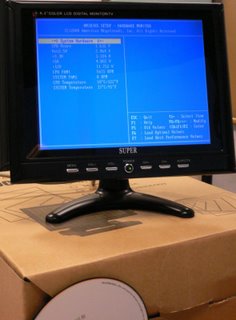 Here is a shot of the BIOS hardware monitor screen. The CPU runs at 1.65v, unfortunately there are no undervolting options. The temperature and fan speed is also monitored, but again no PWM support to control the fans.
Here is a shot of the BIOS hardware monitor screen. The CPU runs at 1.65v, unfortunately there are no undervolting options. The temperature and fan speed is also monitored, but again no PWM support to control the fans.
 As for boot devices, the BIOS does allow for a plethora of options including USB removable media. Hmm... how about booting and running the OS off a USB flashdrive!? I searched the internet and came upon BartPE , which is a stripped down version of Windows XP that can be boot from a CD (and also USB flash drive) used mainly for system maintenance purposes. This is probably better explained in Wiki. I managed to get BartPE to boot off a USB flash drive on my Asus Pundit system, as the BIOS allows the USB drive to emulate a regular hard drive,
As for boot devices, the BIOS does allow for a plethora of options including USB removable media. Hmm... how about booting and running the OS off a USB flashdrive!? I searched the internet and came upon BartPE , which is a stripped down version of Windows XP that can be boot from a CD (and also USB flash drive) used mainly for system maintenance purposes. This is probably better explained in Wiki. I managed to get BartPE to boot off a USB flash drive on my Asus Pundit system, as the BIOS allows the USB drive to emulate a regular hard drive,
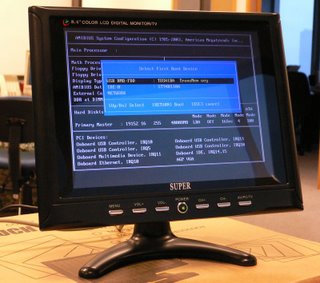
but on the Via system, my Toshiba USB flash drive was only recognized as a floppy which does not work with BartPE. So I had to abandon this option and search further for a USB flash drive bootable OS. Eventually I came across a string of linux distros including DSL (Damn Small Linux), Feather Linux, and Puppy Linux. Being unfamiliar with Linux, I have always been shy to try it. However I ended up deciding to try Puppy Linux as there were several reviews mentioning successful USB boots using the easy install wizard that came with the distro, perfect for someone unfamiliar with Linux. Also there seems to be quite an active Puppy community with a lively forum and continuing upgrades, much more so than the other small distros.
Additional benefits include that Puppy loads completely into RAM and runs off RAM without needing to read/write to the flash drive during the session; only upon exiting will Puppy save/write changes to the USB flash drive. This is advantageous as USB flash drives have limited write cycles - even though the number of cycles is quite large, constant writing will likely wear out the USB flash drive sooner. On the other hand this does mean if there is a sudden power cut, any work will be lost, but if the data is saved to a server then this is not an issue. In addition with the entire OS loaded into RAM, the system should run faster. Well some of you may think that means the system needs a lot of memory, but actually the entire OS is only 60MB and will run on a system with as little as 128MB RAM.
The installation steps are quite simple.
1) downloaded the .ISO file
2) burned it to a CD using Nero (other CD burner utitilities will also work)
3) booted the live-CD
4) followed the setup questions/prompts to get into the OS
5) ran the USB install wizard (USB flash drive was plugged in before bootup)
6) booted Puppy Linux from the USB flash drive!
I initially tried Chubby Puppy, which includes Open Office. This booted without problem from the CD, USB install script ran succesfully, but when booting from the USB flash drive, a list of errors appeared and Puppy did not start up. Instead I tried the official version 2.02 (without Open Office) and reran the newer Install wizard and this time everything worked fine. Booting from USB was really a piece-of-cake with this wizard, just simply answering a few questions and following a few prompts!!
ENCLOSURE
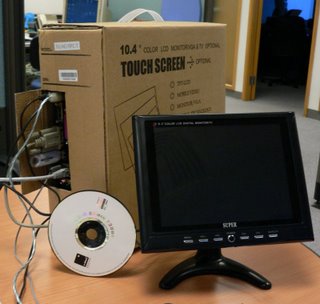 The system ran fine and temperatures were acceptable under load in the smaller cardboard box test setup. I tried to find a similar sized metallic budget case, but I could only find a larger book-type PC case.
The system ran fine and temperatures were acceptable under load in the smaller cardboard box test setup. I tried to find a similar sized metallic budget case, but I could only find a larger book-type PC case.
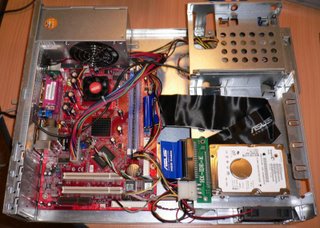 Even this case is too large and there is a lot of extra unused space. Basically the front half of the case (right side in the photo) could be cut off as the system has no optical drive, and the hard drive could be squeezed above the PCI slots, but we won't attempt that here.
Even this case is too large and there is a lot of extra unused space. Basically the front half of the case (right side in the photo) could be cut off as the system has no optical drive, and the hard drive could be squeezed above the PCI slots, but we won't attempt that here.
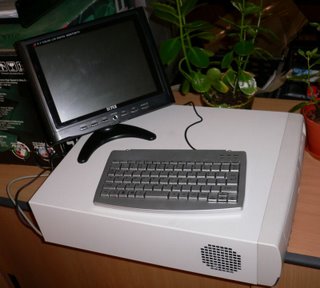 The power supply is a custom size, slightly smaller but longer than the mATX power supply. In addition to the PSU fan, the case also has a small 60cm fan next to where the HDD is installed. Don't be misled by the tiny keyboard, it's actually only 9" (or 23 cm) wide, and of course that's only a 8.4" LCD (1/4 the surface size of a 17"). The tiny keyboard was just handy for the install, a barcode reader will actually be used for most of the data input.
The power supply is a custom size, slightly smaller but longer than the mATX power supply. In addition to the PSU fan, the case also has a small 60cm fan next to where the HDD is installed. Don't be misled by the tiny keyboard, it's actually only 9" (or 23 cm) wide, and of course that's only a 8.4" LCD (1/4 the surface size of a 17"). The tiny keyboard was just handy for the install, a barcode reader will actually be used for most of the data input.
TEMPERATURE AND POWER CONSUMPTION
Using Speedfan to read the temperatures from the motherboard sensors, and a clamp meter to measure the VA power draw at the AC outlet:
This is inside the steel book-type case running Windows XP. These readings were taken inside an air-conditioned office, so I am guessing the ambient was around 24-25C.
STATE = POWER - CPU - MB - HDD
IDLE = 56VA - 38C - 30C - 26C
PRIME95 = 74VA - 57C - 35C - 27C
As the generic case power supply has no PFC the actual AC power consumption in watts should be significantly lower, maybe only 60% of the stated VA figures. In anycase the power consumption figures are very low, and remember this already INCLUDES the power consumed by the LCD as it is powered directly off the PC power supply. With the HDD directly next to the fan, it runs very cool.
FINAL CONFIGURATION
$55 = PC Chips M789CG Motherboard with VIA C3 800mhz CPU
$25 = 256MB DDR400 RAM
$55 = 40GB 2.5" ATA Notebook HDD
$100 = 8.4" LCD Monitor (800x600 native)
$35 = Generic Book-type PC case with PSU
$0 = Puppy Linux OS
--------------------------
$270 TOTAL
Ok, the title does read under $260, well a notebook HDD can easily be replaced by a regular 3.5" 80GB HDD which only costs $45 resulting in a $10 savings.
Alternatively the HDD can be eliminated altogether and replaced with a USB Flashdrive. The one I used is a Toshiba 512MB which cost $15, giving a total system cost of only $230.
How about noise, well although it is not a loud system, with the generic PSU fan, tiny 60mm case fan, and tiny heatsink fan, certainly it does not qualify as a quiet system either. However there is a lot of silencing, potential, especially with such a low power consumption system and diskless OS!
Back to Tiny Motherboard with 5W Processor for $60 Goto Linux on the Wall
Read more!
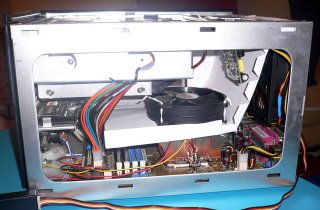 Will a motherboard duct better direct the airflow inside a small form factor PC to cool it's components more efficiently and quietly? A quick experiment to answer this question.
Will a motherboard duct better direct the airflow inside a small form factor PC to cool it's components more efficiently and quietly? A quick experiment to answer this question.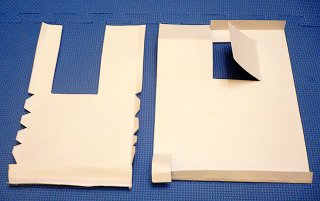 Cut from two pieces of thin cardboard.
Cut from two pieces of thin cardboard.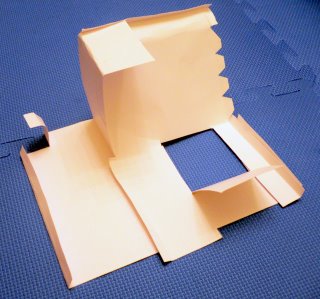 Roughly what the duct looks like.
Roughly what the duct looks like. The duct height runs just above the ram and is wedged between the CPU heatsink and it's 92mm fan. The duct extends from the rear of the case (where it is sealed just above the 120mm case fan) towards the front of the motherboard where it is left open.
The duct height runs just above the ram and is wedged between the CPU heatsink and it's 92mm fan. The duct extends from the rear of the case (where it is sealed just above the 120mm case fan) towards the front of the motherboard where it is left open. Top view.
Top view.  Here the case side panels are installed, the duct is taped to the panel to form a seal.
Here the case side panels are installed, the duct is taped to the panel to form a seal.
 Airflow is blown down into the duct by the CPU fan as well as drawn in from the opening at the front of the motherboard (left side in the photo) and drawn out through the rear case fan. The case side panels also has intake vents that coincedentally fall inside the duct height and will provide additional fresh air intake.
Airflow is blown down into the duct by the CPU fan as well as drawn in from the opening at the front of the motherboard (left side in the photo) and drawn out through the rear case fan. The case side panels also has intake vents that coincedentally fall inside the duct height and will provide additional fresh air intake. The duct fits closely to the 120mm case fan, but hopefully should not be overly restrictive for airflow.
The duct fits closely to the 120mm case fan, but hopefully should not be overly restrictive for airflow.
